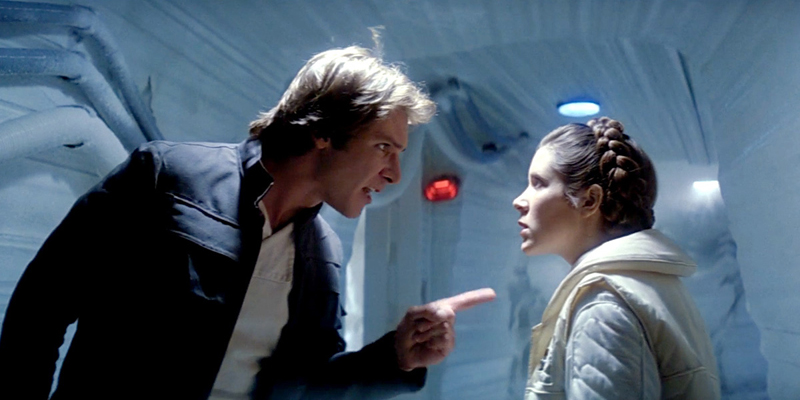
Examining my love life is a bit like overturning a large rock in a damp, dark forest. There are all manner of squishy, squirmy, eyeless horrors wriggling in the mud, things I could dissect and bisect that would still live quite contently, however horridly, in all their undulating halves. There is simply no microscope strong enough, no section small enough, to arrive at the nucleus of why we love whom we love, but oh, do we try.
So which wormy creature to examine first? How to choose? Where did I first learn what love looked like? I can start at my parents—as Maria von Trapp said, the very beginning is a very good place to start. But it’s also often depressing. Shove that wriggler back down into the muck. There are more enjoyable, more relatable critters at hand.
Unlike our parents, many Gen X/Y/Millennial children grew up under the warm glow of a television set. Good or bad, we learned a lot about love from our TVs. A plethora of moralistic rocks exist in all of our life forests. Hate stones, friendship pebbles, family boulders—upend them and rest assured your trusty TV set deposited many of the little nightmares nestled underneath.

Star Wars provided my first peek at on-screen romance. The space opera introduced me to a young, headstrong Princess Leia and caddish Han Solo. When they initially meet, Han Solo quips, “Either I’m going to kill her or I’m beginning to like her!” Love or murder! How to choose? Silver-tongued, brash, and unrelenting, both characters embraced an acerbic antagonism immediately familiar to me. Often, this is what love looked like in my house. I can assure you it’s a relationship mode that fares far better on screen than off, although given their status as of Episode VII, it seems celluloid may have caught up with reality. Salting your relationship with hostility grows the bitterest fruit.
When I was about 13 years old, I developed a crush on a tall, gangly, louche manboy whose name escapes me, thank god, because I was irretrievably besotted and I can’t go down that road again. He smoked cigarettes, wore JNCO jeans at half mast, and sported a swarthy scruff of fuzz above his upper lip and on the tip of his chin. Frequently in trouble at school, he intrigued me. While he didn’t pilot a Corellian light freighter (ie, the Millenium Falcon), he was certainly a cad. And he hated me, utterly. So of course, I loved him. I sniped at him, displaying the unfathomable depths of my crudeness—as would any good princess in the Resistance—and he promptly launched a long campaign of ignoring me outwardly and ridiculing me covertly. It made junior high school pretty unpleasant. Needless to say, boys—nasty or otherwise—don’t really like mean girls with sharp tongues. As is evidenced by my husband’s gentle admonishments, I’m still learning that lesson.
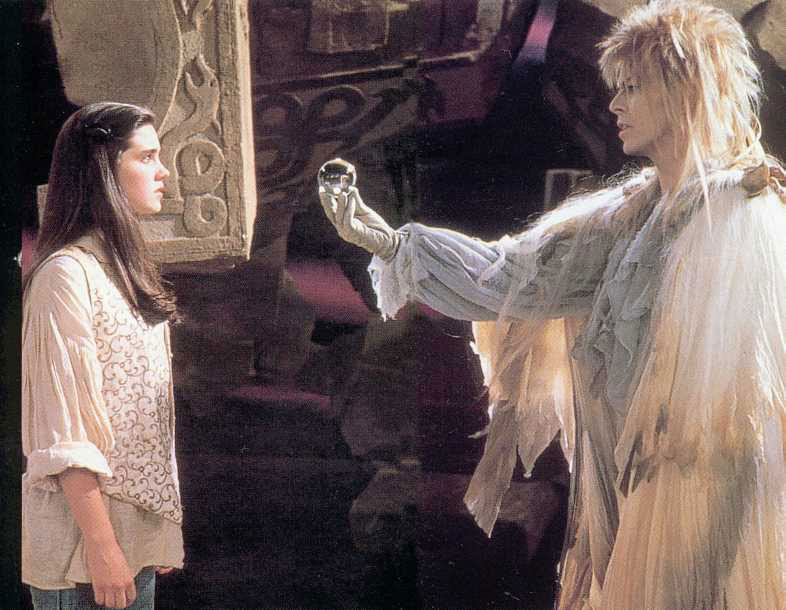
Labyrinth taught me about gaslighting, but perhaps not in the way one would hope. I was undeniably smitten with David Bowie’s Goblin King. I knew he was a bad guy, but he had the tastiest dance magic I’d ever seen. It didn’t bother me that he essentially stole Sarah’s (Jennifer Connelly) little brother and blamed her for it (who hadn’t wished a sibling away in a fit of petulant anger? I have 3 siblings and I routinely prayed each of them away on a rotating schedule), or that all she had to do was give up her life, friends, and family to become queen of his Escheresque kingdom. It did not matter. If that’s what it meant to love the Goblin King, show me the dotted line so I could sign.
The boy I dated in high school didn’t gaslight me, per se, but he did make me feel like I was crazy for loving him. Which I guess is gaslighting, and I’m probably actually gaslighting myself for excusing him. Oh, the magic of being a woman in love! I don’t think he was being deliberately cruel, but I do believe men can be careless and too quick to dismiss women’s feelings under a “females are emotional” banner. Call it Unintentional Delegitimization by Gaslight (it sounds like a very unpleasant old-timey dinner theater show).
If I wanted to spend time with him, I was needy. The music I listened to was stupid, simplistic, and outdated. We somehow always hung out with his friends (never mine) and I often had to figure out my own way home. I still remember buying him a Sandman trade paperback (Volume 4., Season of Mists) with the original Dave McKean cover illustration despite desperately wanting it for myself. I’m not even sure I bought it for him. I think he was just there and happily accepted it because why else would I be buying it? Certainly not for me.
Yikes, guys. I’m tempted to smash everything under this rock and run like hell out of this forest, but let’s press on.
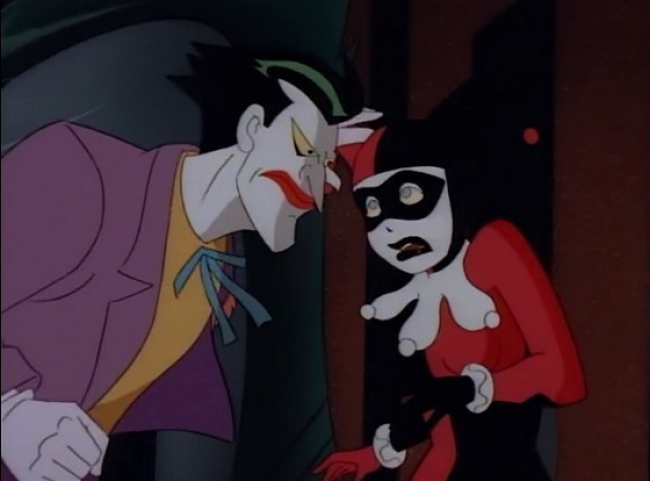
I saw Batman in theaters when I was eight years old and yes I had a crush on Michael Keaton, so you can stuff your arguments about how he was a terrible choice for the role. From the moment he said, “I’m Batman,” my heart whispered I’m yours. If you know anything about Batman it’s that he maps a terrible blueprint for a successful love life. The man is perpetually alone. A whirling carousel of infatuated women fall at his feet and he picks the ones he wants, loves them ephemerally, and then moves on. I wanted to be all those women. Worse still, when the seminal Batman: The Animated Series began in the early 90s, my infatuation spread to other, less seemly, characters. Before there was Suicide Squad, there was the impeccably voiced Joker (Mark Hamill) and Harley Quinn (Arleen Sorkin) of the animated series. Their love was twisted, abusive, questionable, yet bizarrely covetable. I raced home every day after junior high to gorge on B:TAS and was especially infatuated with their caustic covenant. I wanted to be as obsessed with a boy as Harley was with the Joker. It didn’t matter if the feeling wasn’t mutual. By design, it couldn’t be. Thankfully, I have since navigated away from many a disinterested boy, but only after desperately seeking their approval à la Harley Quinn. To wit…
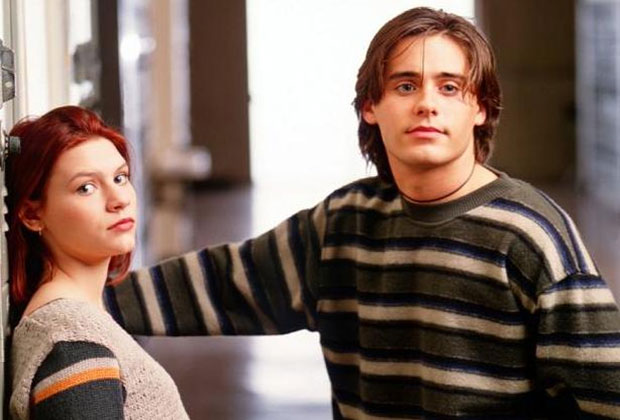
My So-Called Life further aided my chronic fascination with disinterested boys. Was there ever a boy more beautifully detached than Jared Leto’s Jordan Catalano? But Jordan required something entirely different from his women. Rather than being bold and brazen, as Star Wars had taught me, I suddenly needed to become mousy and timid. Where Han Solo craved the verbose, domineering, in-your-face attitude of Princess Leia, Jordan Catalano shied away after more than a few sparse sentences from Angela Chase (Claire Danes).
Which brings me back to my high school boyfriend. Amidst his gaslighting (which I still have trouble defining as such, so deep is my shame), I was a woman enthralled. We formed an ouroboros of apathy and obsession. To use the parlance of the late aughts, he was “just not that into me,” and his stoic rejection only fuelled my longing for him. I constantly sought his approval, at turns using my wit to beguile him then retreating cautiously when I felt him withdraw. I was smart and funny but totally contrived, decrypting the smallest gestures and remarks to conceive and craft what he wanted. I was too available, too invested, and too much. I realized (much later) that his indifference was a Sisyphean challenge to my self-worth. I wasn’t meant to conquer his affections. If I had, he may have lost my respect and all of his appeal. Like many young women with low self-esteem and a precarious identity, his rejection was the only thing giving me shape and form.
I still wonder: was I truly being gaslit, or was I an emotional nightmare? In the crucible of hormones, terrible media examples, and carceral gender expectations—for both men and women—I can’t really be sure. And in that sense, I’m an unreliable narrator, even to myself. Whatever the case, I decamped that relationship thoroughly dazed and unsure of what had occurred and I’m convinced that foggy confusion was less about being lost in love and more about being in a fugue state.
Movies and TV offered terribly incongruous love advice. The results were decidedly disfiguring. A bad boy craves a pushy girl. A recluse tolerates a mouse. The message was static, despite the drastically different tastes of the men. It was less about whom I wanted, and more about whom I needed to become to attract certain types. Cater your personality to your paramour, the media declared.
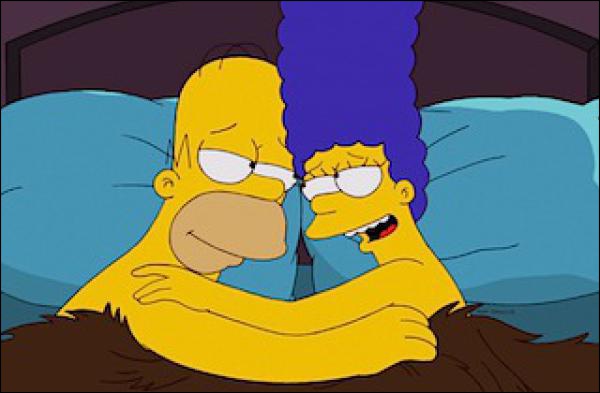
Thankfully, one enduring television relationship had a positive influence: that of Marge and Homer Simpson. As a thirty-something, The Simpsons began at the perfect time to warp and mold my little mind. Homer drove Marge crazy with his hare-brained schemes and antics and Marge irritated Homer with her endless nagging, but neither character ever changed a thing about themselves to stay in love. Both terribly flawed, multidimensional characters embraced their partner’s foibles as essential to the relationship. It was a love of acceptance, patience, and true friendship. It took me too long to realize the best example of a loving relationship had been consistently streaming directly into my brain every Sunday at 8pm. But you don’t particularly desire Homer Simpson when you’re 8/12/22/30 years old—I’m not sure when you’re supposed to start hankering for Homer. I never have. But I did start wanting that relationship, that connection, that love. A love where I could be annoying, witless, messy, gutsy, withdrawn, impetuous, imperfect, and persnickety and someone would love me not despite but because of all those things. I’m lucky enough to say I’ve finally found someone with whom I can be ugly and obsessive, crude and careless. I watch him do the same weird mating dance right back at me and love him all the same.
The Simpsons‘ message was simple, yet revolutionary. Just be you. Love will follow.



